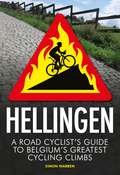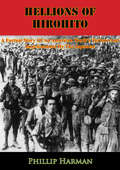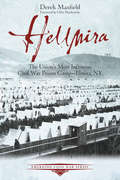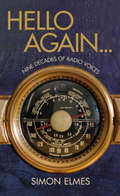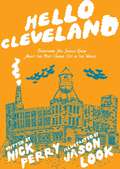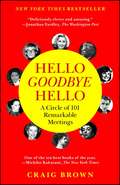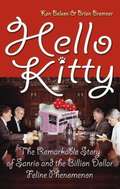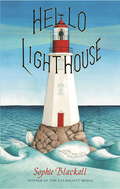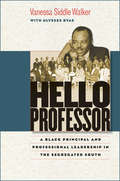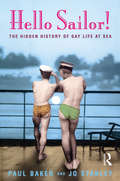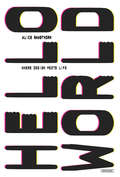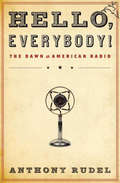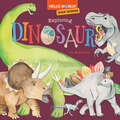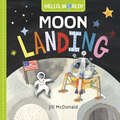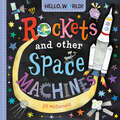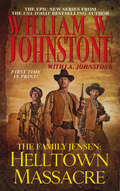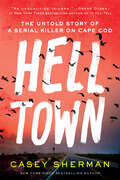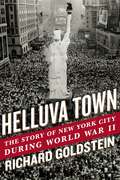- Table View
- List View
Hellingen: A Road Cyclist's Guide to Belgium's Greatest Cycling Climbs
by Simon WarrenFrom the author who brought you 100 Greatest Cycling Climbs comes another essential guide to vertical pain. This time Simon Warren has turned his attention to the famous climbs of Belgium and the ascents that define the world's greatest single-day bike races. From the rugged cobbles of the Tour of Flanders (or De Ronde), which takes place in early April each year, to the jagged peaks of Liège-Bastogne-Liège, also in April, and beyond, this pocket guide pinpoints fifty climbs that once ridden will give a true appreciation of the races they epitomise. If you thought Belgium was flat . . . think again.
Hellions Of Hirohito: A Factual Story Of An American Youth's Torture And Imprisonment By The Japanese
by Phillip HarmanThis is a factual story of a young American civilian imprisoned and tortured by the Japanese when they conquered Hong Kong. In a foreword by General Russell Hearn, who was instrumental in organizing the quasi-military Flying Tigers, there is an interesting personal reaction to the events described in the book in which he states for the record that "I believe there is no race of people on this earth quite as treacherous as the Japanese. Theirs is a treachery veiled by soft words and cunning smiles." Harman's account mostly mirrors this sentiment. The book itself dwells on the inadequacy of the Allied defense in Hong Kong, the brave efforts of the volunteers and civilians to hold the city, and the brutal acts committed by the victorious enemy against British and American civilians. Harman found himself stranded when the city fell, having worked for several years in the East on behalf of the United China Relief agency. Reporting on the beatings, the inadequate food, even the wanton incidents of Japanese soldiers raping women, he tells a story told before, including bouts of dysentery and afflictions of beri-beri while in captivity. Eventually, Harman describes his return to safety in America when he was exchanged for a Japanese national stranded in the United States.--Great Stories of World War II
Hellmira: The Union's Most Infamous Civil War Prison Camp—Elmira, NY (Emerging Civil War Series)
by Derek MaxfieldLong called by some the “Andersonville of the North,” the prisoner of war camp in Elmira, New York, is remembered as the most notorious of all Union-run POW camps. It existed for only a year—from the summer of 1864 to July 1865—but in that time, and for long after, it became darkly emblematic of man’s inhumanity to man. Confederate prisoners called it “Hellmira.” Hastily constructed, poorly planned, and overcrowded, prisoner of war camps North and South were dumping grounds for the refuse of war. An unfortunate necessity, both sides regarded the camps as temporary inconveniences—and distractions from the important task of winning the war. There was no need, they believed, to construct expensive shelters or provide better rations. They needed only to sustain life long enough for the war to be won. Victory would deliver prisoners from their conditions. As a result, conditions in the prisoner of war camps amounted to a great humanitarian crisis, the extent of which could hardly be understood even after the blood stopped flowing on the battlefields. In the years after the war, as Reconstruction became increasingly bitter, the North pointed to Camp Sumter—better known as the Andersonville POW camp in Americus, Georgia—as evidence of the cruelty and barbarity of the Confederacy. The South, in turn, cited the camp in Elmira as a place where Union authorities withheld adequate food and shelter and purposefully caused thousands to suffer in the bitter cold. This finger-pointing by both sides would go on for over a century. And as it did, the legend of Hellmira grew. In Hellmira: The Union’s Most Infamous POW Camp of the Civil War, Derek Maxfield contextualizes the rise of prison camps during the Civil War, explores the failed exchange of prisoners, and tells the tale of the creation and evolution of the prison camp in Elmira. In the end, Maxfield suggests that it is time to move on from the blame game and see prisoner of war camps—North and South—as a great humanitarian failure.
Hello Again: Nine decades of radio voices
by Simon ElmesIt’s now ninety years since the BBC made its first broadcast and the British love affair with radio began.This book is a journey through that fascinating history and a celebration of the many wonderful voices that were part of it: Marion Cran, who pioneered the first gardening programme in the 1920s; The Goons and Kenneth Horne, comedy greats of the 1950s; John Peel, Alan Freeman, Kenny Everett and other heroes of the pirate stations; all the way up to Eddie Mair, Fi Glover and Danny Baker, the much-loved voices of today. A delightful blend of insight, history and nostalgia, Hello Again will appeal to any radio aficionado.
Hello Cleveland: Things You Should Know About the Most Unique City in the World
by Nick PerryHello Cleveland unlocks the hidden, larger-than life history and culture of Cleveland, Ohio, possibly the country's most misunderstood city. Locals, visitors, transplants, and people—who moved away as soon as they could—will gain a well-rounded picture of the city's passionate pursuits, dark corners, dubious claims to fame, and disarmingly friendly culture. Nick Perry, who grew up in Cleveland and then moved back as an adult, invites you to join him in taking a loving, brutally honest look under the hood. Develop an appreciation for local celebrities like Devo, Bone Thugs & Harmony, Lil' John and Big Chuck, and Dick Goddard the weather guy. Marvel at landmarks like the Great Lakes, the Metroparks, and the world's largest outdoor chandelier. There are plenty of downsides and none are sugarcoated. You'll discover why Cleveland is the reason for the creation of the Environmental Protection Act and how it's largely to blame for the widespread adoption of suburban city planning. But you can still find a heartwarming pride in rooting for sports teams that seem cursed to lose every championship. As the city's unofficial slogan says, "You've got to be tough," but there's a lot to love—especially when the world-famous Cleveland Orchestra wanders into the dive bar you're sitting in and starts to play an impromptu concert.
Hello Goodbye Hello
by Craig BrownHello Goodbye Hello is a daisy chain of 101 fascinating true encounters, a book that has been hailed by reviewers in London as "howlingly funny" (The Spectator), "original and a complete delight" (The Sunday Times), and "rich and hugely enjoyable" (The Guardian). Or, as the London Evening Standard put it, "the truth and nothing but the plain, bonkers, howling truth . . . It is partly a huge karmic parlour game, partly a dance to the music of chaos--and only the genius of Craig Brown could have produced it." Who could imagine such unlikely--but true-- encounters as these: Martha Graham meets Madonna Igor Stravinsky meets Walt Disney Frank Lloyd Wright meets Marilyn Monroe Marilyn Monroe meets Nikita Khrushchev President Richard Nixon meets Elvis Presley Harpo Marx meets George Bernard Shaw Cecil Beaton meets Mick Jagger Salvador Dali meets Sigmund Freud Groucho Marx meets T.S. Eliot Brilliant in conception, Hello Goodbye Hello shows how the celebrated and gifted--like the rest of us-- got along famously or disastrously or indifferently with one another, but, thanks to Craig Brown, always to our amusement and entertainment. From an opening story in which Adolf Hitler survives being knocked down by a careless English driver in 1931 to the Duchess of Windsor's meeting with the FÜhrer over tea, and 99 others in between, Hello Goodbye Hello is the perfect example that truth is stranger than fiction (and infinitely more enjoyable).
Hello Kitty: The Remarkable Story of Sanrio and the Billion Dollar Feline Phenomenon
by Ken Belson Brian BremnerHello Kitty is Japan's brilliant answer to Disney's Mickey Mouse phenomenon in the U.S. This book explains how Sanrio, the company behind Hello Kitty, turned a cute cartoon cat into a multi-billion dollar global commodity.
Hello Lighthouse
by Sophie BlackallA beautiful picture book about hope, change and the passing of time. Winner of the Caldecott Medal 2019.On the highest rock of a tiny island at the edge of the world stands a lighthouse. From dusk to dawn, the lighthouse beams, sending its light out to sea, guiding the ships on their way. As the seasons pass and the waves rise and fall, outside, the wind blows; inside, the lighthouse keeper writes, and the rhythms of his life unfold. But change is on the horizon...With beautiful illustrations from Sophie Blackall - the artist behind New York Times bestseller, Finding Winnie."I will be surprised if a more exquisite picture book is published this year" - New York Times"A jewel of a creation" - Publishers Weekly
Hello Professor: A Black Principal and Professional Leadership in the Segregated South
by Vanessa Siddle Walker Ulysses ByasLike many black school principals, Ulysses Byas, who served the Gainesville, Georgia, school system in the 1950s and 1960s, was reverently addressed by community members as "Professor." He kept copious notes and records throughout his career, documenting efforts to improve the education of blacks. Through conversations with Byas and access to his extensive archives on his principalship, Vanessa Siddle Walker finds that black principals were well positioned in the community to serve as conduits of ideas, knowledge, and tools to support black resistance to officially sanctioned regressive educational systems in the Jim Crow South. Walker explains that principals participated in local, regional, and national associations, comprising a black educational network through which power structures were formed and ideas were spread to schools across the South. The professor enabled local school empowerment and applied the collective wisdom of the network to pursue common school projects such as pressuring school superintendents for funding, structuring professional development for teachers, and generating local action that was informed by research in academic practice. The professor was uniquely positioned to learn about and deploy resources made available through these networks. Walker's record of the transfer of ideology from black organizations into a local setting illuminates the remembered activities of black schools throughout the South and recalls for a new generation the role of the professor in uplifting black communities.
Hello Sailor!: The hidden history of gay life at sea
by Paul Baker Jo StanleyWhen gays had to be closeted, ships were the only places where homosexual men could not only be out but also camp. And on some liners to the sun and the New World, queens and butches had a ball. They sashayed and minced their way across the world's oceans. Never before has the story been told of the masses. These are the thousands of queer seafarers, mainly stewards, who sometimes even outnumbered the straight men in the catering departments of ships that were household names and the pride of the British fleet. Hello Sailor! uniquely shows what it was like to be queer at sea at a time when land meant straightness.
Hello Stranger (The Ravenels #4)
by Lisa KleypasNew York Times bestselling author Lisa Kleypas delivers a scintillating tale of an unconventional beauty who finds passion with the spy who can't resist her - perfect for fans of Sarah MacLean, Julia Quinn and Eloisa James. 'Lisa Kleypas is the best' Sarah MacLean A woman who defies her time . . . Dr. Garrett Gibson, the only female physician in England, is as daring and independent as any man - why not take her pleasures like one? Yet she has never been tempted to embark on an affair, until now. Ethan Ransom, a former detective for Scotland Yard, is as gallant as he is secretive, a rumoured assassin whose true loyalties are a mystery. For one exhilarating night, they give in to their potent attraction before becoming strangers again. A man who breaks every rule . . . As a Ravenel by-blow spurned by his father, Ethan has little interest in polite society, yet he is captivated by the bold and beautiful Garrett. Despite their vow to resist each other after that sublime night, she is soon drawn into his most dangerous assignment yet. When the mission goes wrong, it will take all of Garrett's skill and courage to save him. As they face the menace of a treacherous government plot, Ethan is willing to take any risk for the love of the most extraordinary woman he's ever known. 'Kleypas can make you laugh and cry - on the same page' Julia Quinn The Ravenels: Cold-Hearted Rake Marrying Winterborne Devil in Spring Hello Stranger Devil's Daughter Chasing Cassandra Praise for Lisa Kleypas: 'Intricately and elegantly crafted, intensely romantic . . . from a not-to-be-missed romance author' Kirkus Reviews'Witty, often hilarious, and delightfully passionate, this compelling, thrill-laced Victorian romance is another superb series entry' Library Journal, starred review'Readers are introduced to the unforgettable characters and their original personalities through a delightful storyline peppered with sharp repartee and steamy sensuality' RT Book Reviews (top pick)'Is it possible to give a book 6 stars? . . . [This] story has all of the forbidden romance, witty banter, and sigh-inducing declarations of love that you deserve' That's Normal
Hello USA: Wyoming
by Carlienne A. FrischIntroduces Wyoming's history, geography, economy, and environmental concerns.
Hello World
by Alice RawsthornHello World is Alice Rawsthorn's definitive guide to design and modern life Design is one of the most powerful forces in our lives. When deployed wisely, it can bring us pleasure, choice, strength, decency and much more. But if its power is abused, the outcome can be wasteful, confusing, humiliating, even dangerous. None of us can avoid being affected by design, whether or not we wish to. It is so ubiquitous that it determines how we feel and what we do, often without our noticing. Hello World explores design's influence on our lives. Written by the renowned design critic Alice Rawsthorn and designed by the award-winning book designer Irma Boom, it describes how warlords, scientists, farmers, hackers, activists and designers have used design to different ends throughout history: from the macabre symbol invented by 18th century pirates to terrorise their victims into surrender, to one woman's quest for the best possible prosthetic legs and the evolution of the World Cup ball. At a time when we face colossal changes, unprecedented in their speed, scale and intensity - from the deepening environmental crisis, to giant leaps in science and technology - Hello World explains how design can help us to make sense of them andto turn them to our advantage. 'Hello World is a new book by Alice Rawsthorn, the one and only, the best design critic in the entire world. She keeps the banner of design flying high. Irma Boom designed it, and Irma is simply the best book designer alive' Paola Antonelli, Senior Curator of Architecture and Design at the Museum of Modern Art, New YorkPraise for Alice Rawsthorn's Yves Saint Laurent'As gripping as a thriller, packed with plot, character and atmosphere' The Times'Rawsthorn's excellent biography isn't merely a story about clothes, but of crises, comebacks and drug clinics, and as a document of the time it is compulsive' Evening Standard'The best book I have ever read about the mesmerising cruelty of fashion' The Spectator'Intelligent and pragmatic. . . this is a page-turner of a book' New Statesman'What a story! A skilful interweaving of the artistic, business and emotional life of a great couture house' Mail on SundayAlice Rawsthorn is the design critic of the International Herald Tribune, the global edition of the New York Times. Her weekly Design column is syndicated worldwide. A trustee of Arts Council England and the Whitechapel Gallery in London, she is chair of trustees at the Chisenhale Gallery and the author of an acclaimed biography of Yves Saint Laurent.
Hello World: Where Design Meets Life
by Alice RawsthornIt is often said that we are living in a new golden age of design. Our gadgets, appliances, and cars are sleeker and more elegant than they’ve ever been; in our free time, we trawl the internet for pictures of flawless minimalist interiors; and even the great industrialist of our time—Steve Jobs—is admired more for his visual savvy than his technological inventiveness. And yet with Instagram and Pinterest at our fingers and great design more available—and more affordable—than ever, we’ve had no guidebook to this ever-fascinating field. Though it’s an inescapable part of our lives, there has been no single book that could, in one fell swoop, tell us everything we need to know about design. Enter Hello World. The design critic for the International Heard Tribune, Alice Rawsthorn has spent many years reckoning with the history of design and with its place in contemporary life, and Hello World is the extraordinary summation of her research and reporting. Rawsthorn takes us on a trip through design that ranges across continents and centuries, and wherever she goes, she discovers inspiring, thrilling examples of resourcefulness, inventiveness, and sheer vision. From the macabre symbol with which eighteenth-century pirates terrorized their victims into surrender, to one woman’s quest for the best prosthetic legs, to the evolution of the World Cup soccer ball, Hello World describes how warlords, scientists, farmers, hackers, activists, and professional designers have used the complex, often elusive process of design to different ends throughout history. Hailed as a “rapid-fire and illuminating ode to contemporary design” (Telegraph) and “an extremely readable tour of the subject” (Financial Times), Hello World is a major work that radically broadens our understanding of what design can mean, and explains how we can use it to make sense of our ever-changing universe.
Hello World: Where Design Meets Life
by Alice RawsthornIt is often said that we are living in a new golden age of design. Our gadgets, appliances, and cars are sleeker and more elegant than they've ever been; in our free time, we trawl the internet for pictures of flawless minimalist interiors; and even the great industrialist of our time--Steve Jobs--is admired more for his visual savvy than his technological inventiveness. And yet with Instagram and Pinterest at our fingers and great design more available--and more affordable--than ever, we've had no guidebook to this ever-fascinating field. Though it's an inescapable part of our lives, there has been no single book that could, in one fell swoop, tell us everything we need to know about design. Enter Hello World. The design critic for the International Heard Tribune, Alice Rawsthorn has spent many years reckoning with the history of design and with its place in contemporary life, and Hello World is the extraordinary summation of her research and reporting. Rawsthorn takes us on a trip through design that ranges across continents and centuries, and wherever she goes, she discovers inspiring, thrilling examples of resourcefulness, inventiveness, and sheer vision. From the macabre symbol with which eighteenth-century pirates terrorized their victims into surrender, to one woman's quest for the best prosthetic legs, to the evolution of the World Cup soccer ball, Hello World describes how warlords, scientists, farmers, hackers, activists, and professional designers have used the complex, often elusive process of design to different ends throughout history. Hailed as a "rapid-fire and illuminating ode to contemporary design" (Telegraph) and "an extremely readable tour of the subject" (Financial Times), Hello World is a major work that radically broadens our understanding of what design can mean, and explains how we can use it to make sense of our ever-changing universe.
Hello, America
by Livia Bitton-JacksonThe year is 1951 and eighteen-year-old Elli and her mother arrive in New York City. Finally they can leave behind bitter Holocaust memories and become real Americans! From office filing all day, to the challenge of night school, to interpreting the intentions of Alex, a handsome and persistent doctor, Elli soon finds learning English is only half as hard as "making it" in this new world. Against a backdrop of soda shops, skyscrapers, and subways, acclaimed author Livia Bitton-Jackson fuses old-world tradition and modern dreams, in this vivid kaleidoscope of immigrant America.
Hello, America
by Livia Bitton-JacksonThe year is 1951 and eighteen-year-old Elli and her mother arrive in New York City. Finally they can leave behind bitter Holocaust memories and become real Americans! From office filing all day, to the challenge of night school, to interpreting the intentions of Alex, a handsome and persistent doctor, Elli soon finds learning English is only half as hard as "making it" in this new world.Against a backdrop of soda shops, skyscrapers, and subways, acclaimed author Livia Bitton-Jackson fuses old-world tradition and modern dreams, in this vivid kaleidoscope of immigrant America.
Hello, Everybody!: The Dawn of American Radio
by Anthony Rudel&“A lively overview&” of this pre-internet mass-communication tool and &“the entrepreneurs and evangelists, hucksters and opportunists&” who flocked to it (Publishers Weekly). Long before the Internet, another young technology was transforming the way we connect with the world. At the dawn of the twentieth century, radio grew from an obscure hobby into a mass medium with the power to reach millions of people. When amateur enthusiasts began sending fuzzy signals from their garages and rooftops, radio broadcasting was born. Sensing the medium&’s potential, snake-oil salesmen and preachers took to the air, innovating styles of mass communication and entertainment while making bedlam of the airwaves. Into this wild new frontier stepped a young secretary of commerce, Herbert Hoover, whose passion for organization transformed radio into an even more powerful political, cultural and economic force. When a charismatic bandleader named Rudy Vallée created the first on-air variety show and America elected Franklin Delano Roosevelt, who communicated with the public through his famous fireside chats, radio had arrived. With extensive knowledge, humor, and an eye for outsized characters forgotten by history, Anthony Rudel tells the story of the boisterous years when radio took its place in the nation&’s living room. &“Entertaining and informative.&” —The Denver Post &“Rudel, with extensive professional radio experience, revels in the enterprising personalities who set up shop on this technological frontier. . . .[And] vividly re-creates the anything-goes atmosphere of the ether&’s early days.&” —Booklist
Hello, World! Dinosaurs (Hello, World!)
by Jill McDonaldLearn from home and explore the world with these fun and easy board books!All young children love dinosaurs. Here&’s a Hello, World! board book that teaches toddlers all about Triceratops, Stegosaurus, T-rex, and many more—with colors, shapes, sizes, and super-simple facts. Hello, World! is a series designed to introduce first nonfiction concepts to babies and toddlers. Told in clear and easy terms (&“T. rex&’s arms were very small, even though its body was large&”) and featuring bright, cheerful illustrations, Hello, World! makes learning fun for young children. And each sturdy page offers helpful prompts for engaging with your child. It&’s a perfect way to bring science and nature into the busy world of a toddler, where learning never stops. Look for all the books in the Hello, World! series: • Solar System• Weather• Backyard Bugs• Birds• Dinosaurs• My Body• How Do Apples Grow?• Ocean Life• Moon Landing• Pets• Arctic Animals• Construction Site• Rainforest Animals• Planet Earth • Reptiles• Cars and Trucks • Music• Baby Animals• On the Farm• Garden Time• Planes and Other Flying Machines• Rocks and Minerals• Snow
Hello, World! Kids' Guides: Exploring Dinosaurs (Hello, World!)
by Jill McDonaldWith 2 million board books sold, Hello, World! has become a trusted toddler-and-preschool series. Now there are Hello, World! Kids' Guides, all-new picture books with a higher reading level and a deeper exploration into each topic.In Exploring Dinosaurs, readers can learn all about prehistoric creatures, with favorites such as T. rex and Stegosaurus, mini dinosaurs the size of a turkey, and even a swimming dinosaur. Dinosaur fans will find:Fascinating details about dinosaurs from the Triassic, Jurassic, and Cretaceous periods.Panels of stats for kids who love data, with information about size, body parts, diet, and more.Questions that ask the reader to think about dinosaurs in relation to themselves, such as "If you discovered a dinosaur, what would you call it?"Loyal Hello, World! fans who are reading on their own, as well as any kid who loves nonfiction, will find many captivating hours of learning and inspiration.
Hello, World! Moon Landing (Hello, World!)
by Jill McDonaldLearn from home and explore the world with these fun and easy board books!Discover all about the first moon landing with the hit nonfiction board book series Hello, World!All young children love to look up at the moon. Now here's a board book that teaches them all about the first moon landing, with easy-to-understand details about the Apollo 11 astronauts, the NASA team, spacesuits, the rocket modules, and the world's celebration after the successful mission.Hello, World! is a series designed to introduce first nonfiction concepts to babies and toddlers. Told in clear and easy terms ("An astronaut's job is to travel into space") and featuring bright, cheerful illustrations, Hello, World! is a perfect way to bring science, nature, and culture into the busy world of a toddler, where learning never stops. Look for all the books in the Hello, World! series: • Solar System• Weather• Backyard Bugs• Birds• Dinosaurs• My Body• How Do Apples Grow?• Ocean Life• Moon Landing• Pets• Arctic Animals• Construction Site• Rainforest Animals• Planet Earth • Reptiles• Cars and Trucks • Music• Baby Animals• On the Farm• Garden Time• Planes and Other Flying Machines• Rocks and Minerals• Snow
Hello, World! Rockets and Other Space Machines (Hello, World!)
by Jill McDonaldBlast off! Young astronauts can explore rockets, rovers, space shuttles, and more in this nonfiction book from the bestselling series Hello, World!Preschoolers and toddlers can learn all about the wide world of spacecraft in this cheerful and informative book—with colorful art and super-simple facts. ("A rocket flies by burning fuel and turning it into hot gas.")Told in easy-to-understand terms alongside bright illustrations of space machines and vehicles, this book makes learning easy for little ones and offers useful prompts to help adults engage with the reader on each page.It's a perfect way to bring science into the busy world of babies, toddlers, and preschoolers, where learning never stops.Look for all the books in the Hello, World! series:Solar System • Weather • Backyard Bugs • Birds • Dinosaurs • My Body • How Do Apples Grow? • Ocean Life • Moon Landing • Pets • Arctic Animals • Construction Site • Rainforest Animals • Planet Earth • Reptiles • Cars and Trucks • Music • Baby Animals • On the Farm • Garden Time • Planes and Other Flying Machines • Rocks and Minerals • Snow • Let's Go Camping • School Day • Bedtime • From Seed to Pumpkin • Rockets and Other Space Machines • Baking
Helltown Massacre: Helltown Massacre (The Family Jensen #2)
by William W. Johnstone J.A. JohnstoneThe Greatest Western Writer Of The 21st CenturyCourage was in the blood. A battle was on the land. Three generations of mountain men, bound by a passion for justice, have come together in William W. Johnstone and J.A. Johnstone's towering new saga--as the legendary Jensens fight for one another's lives on the untamed American frontier. . .One Family. One Cause. One Deadly Mistake. . .A woman and an iron horse put Matt Jensen in the crosshairs of a man out to reap a fortune with a new railroad through Paiute land. First Cyrus Longacre steals the land. Next he frames Matt Jensen for the murder of a beautiful woman. The final step is to keep Matt's father and grandfather far away from Nevada Territory. . . Preacher and Smoke are otherwise engaged--until some hired killers get their attention. Suddenly, the elder Jensens have a hunch young Matt is in trouble and together they're riding to Paiute country. They have a hanging to stop and a war to start: three men against a half a hundred. Impossible odds. Unless your name is Jensen.
Helltown: The Untold Story of a Serial Killer on Cape Cod
by Casey ShermanBefore Charles Manson, there was Tony Costa—the serial killer of Cape Cod1969: The hippie scene is vibrant in Provincetown, Massachusetts. Long-haired teenagers roam the streets, strumming guitars and preaching about peace and love... and Tony Costa is at the center of it all. To a certain group of smitten young women, he is known as Sire—the leader of their counter-culture movement, the charming man who speaks eloquently and hands out hallucinogenic drugs like candy. But beneath his benign persona lies a twisted and uncontrollable rage that threatens to break loose at any moment. Tony Costa is the most dangerous man on Cape Cod, and no one who crosses his path is safe.When young women begin to disappear, Costa's natural charisma and good looks initially protect him from suspicion. But as the bodies are discovered, the police close in on him as the key suspect. Meanwhile, local writers Kurt Vonnegut and Norman Mailer are locked in a desperate race to secure their legacies as great literary icons—and they both set their sights on Tony Costa and the drug-soaked hippie culture that he embodies as their next promising subject, launching independent investigations that stoke the competitive fires between two of the greatest American writers.Immersive, unflinching, and shocking, Helltown is a landmark true crime narrative that transports us back to the turbulent late 1960s, reveals the secrets of a notorious serial killer, and unspools the threads connecting Costa, Vonnegut, and Mailer in the seaside city that played host to horrors unlike any ever seen before. New York Times bestselling author Casey Sherman has crafted a stunner.
Helluva Town
by Richard GoldsteinIn the stirring signature number from the 1944 Broadway musical On the Town, three sailors on a 24-hour search for love in wartime Manhattan sing, "New York, New York, a helluva town." The Navy boys' race against time mirrored the very real frenzy in the city that played host to 3 million servicemen, then shipped them out from its magnificent port to an uncertain destiny. This was a time when soldiers and sailors on their final flings jammed the Times Square movie houses featuring lavish stage shows as well as the nightclubs like the Latin Quarter and the Copacabana; a time when bobby-soxers swooned at the Paramount over Frank Sinatra, a sexy, skinny substitute for the boys who had gone to war. Richard Goldstein's Helluva Town is a kaleidoscopic and compelling social history that captures the youthful electricity of wartime and recounts the important role New York played in the national war effort. This is a book that will prove irresistible to anyone who loves New York and its relentlessly fascinating saga. Wartime Broadway lives again in these pages through the plays of Lillian Hellman, Robert Sherwood, Maxwell Anderson, and John Steinbeck championing the democratic cause; Irving Berlin's This Is the Army and Moss Hart's Winged Victory with their all-servicemen casts; Rodgers and Hammerstein's Oklahoma! hailing American optimism; the Leonard Bernstein-Jerome Robbins production of On the Town; and the Stage Door Canteen. And these were the days when the Brooklyn Navy Yard turned out battleships and aircraft carriers, when troopships bound for Europe departed from the great Manhattan piers where glamorous ocean liners once docked, where the most beautiful liner of them all, the Normandie, caught fire and capsized during its conversion to a troopship. Here, too, is an unseen New York: physicists who fled Hitler's Europe spawning the atomic bomb, the FBI chasing after Nazi spies, the Navy enlisting the Mafia to safeguard the port against sabotage, British agents mounting a vast intelligence operation. This is the city that served as a magnet for European artists and intellectuals, whose creative presence contributed mightily to New York's boisterous cosmopolitanism. Long before 9/11, New York felt vulnerable to a foreign foe. Helluva Town recalls how 400,000 New Yorkers served as air-raid wardens while antiaircraft guns ringed the city in anticipation of a German bombing raid. Finally, this is the story of New York's emergence as the power and glory of the world stage in the wake of V-J Day, underlined when the newly created United Nations arose beside the East River, climaxing a storied chapter in the history of the world's greatest city.
